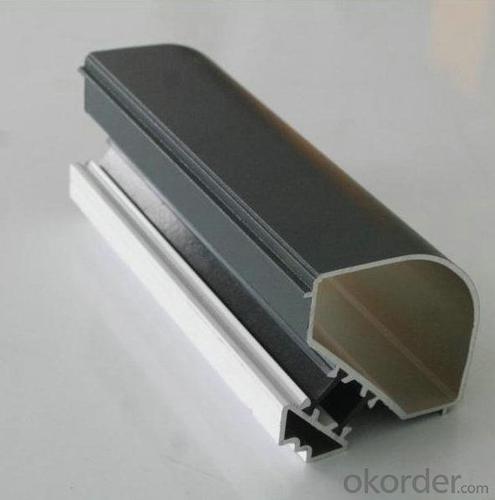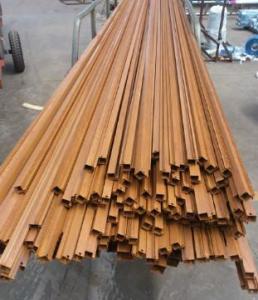Customized Schuco Aluminum Extrusion Profile
- Loading Port:
- China Main Port
- Payment Terms:
- TT OR LC
- Min Order Qty:
- -
- Supply Capability:
- -
OKorder Service Pledge
Quality Product, Order Online Tracking, Timely Delivery
OKorder Financial Service
Credit Rating, Credit Services, Credit Purchasing
You Might Also Like
Material | Alloy 6063,6061,6005or according to customer’s choice |
Temper | T3, T4, T5, T6 |
Surface | Anodize, electrophoresis, powder coating, PVDF coating, wood grain painting, matted, etc. |
Color | Any colour based on Standard Germany RAL Mark |
Length | Coating 6.5 meters, Anodizing 6.5 meters, Mill finish 5 meters |






- Q: What is the price of aluminum paint spray?
- It can also be calculated according to the weight. Do you have more aluminum profiles to be painted?
- Q: What cutting tool is better for cutting aluminum profile? Because this aluminum alloy material is used for radiator, there is 3mm thick sheet, it is standing up, and cutting to make it easy to deformation, which requires very sharp knives. After cutting for a period of time with a high speed steel tool, the tool is a little bit worn out, and the material starts to deform and the tool can no longer be used. Is it reasonable to use a corn cutter? Or it can be better solved with other tools or techniques.
- The blade has no chamfering and is very sharp.On condition emulsion, in which the mineral oil content is higher, is advantageous to the lubrication.Corn milling is not necessary, aluminum alloy cutting efficiency is very high, do not need big cutting tool, and you say that the workpiece is easy to deformation, not to use corn milling this high cutting impedance tool
- Q: Is it feasible to recycle aluminum profiles economically and in significant quantities?
- <p>Yes, aluminum profiles can be recycled at a reasonable cost and volume. Recycling aluminum is more cost-effective than mining and refining new aluminum from bauxite. The process requires less energy, which reduces costs. Additionally, aluminum has a high recycling rate, with about 75% of all aluminum ever produced still in use today. This indicates that aluminum recycling is both economically viable and can be done in significant volumes, contributing to sustainability and waste reduction.</p>
- Q: 120 and 150 hidden frame glass curtain wall aluminum profile per square meter dosage, there may be curtain wall quotation cost analysis table
- Aluminum curtain wall is about 8-10kg/ square meters.I don't have any formAt present, the price of aluminum profile is 20-30 yuan /kg (anodizing, powder spraying, fluorocarbon spraying and other surface treatment)A window sash is glass, aluminum, metal fittings, glue, these things, aluminum, glass is accounted for the bulk
- Q: Are aluminum profiles suitable for high-traffic areas?
- Yes, aluminum profiles are suitable for high-traffic areas. Aluminum is a durable and lightweight material that can withstand heavy use and frequent movement. It is resistant to corrosion and can maintain its structural integrity even in high-traffic environments. Additionally, aluminum profiles can be designed to meet specific safety and aesthetic requirements, making them an ideal choice for areas with a large volume of foot traffic.
- Q: Are aluminum profiles suitable for use in the mining industry?
- Yes, aluminum profiles are suitable for use in the mining industry. Aluminum is a lightweight, yet strong and durable material that offers numerous advantages for mining applications. One key advantage of aluminum profiles is their excellent corrosion resistance. In the mining industry, where equipment is often exposed to harsh environmental conditions and chemicals, this corrosion resistance is crucial. Aluminum profiles can withstand exposure to moisture, chemicals, and other corrosive substances without deteriorating, ensuring long-lasting performance and reducing maintenance costs. Another benefit of aluminum profiles is their high strength-to-weight ratio. Aluminum is significantly lighter than other metals commonly used in mining equipment, such as steel. This lightweight characteristic makes aluminum profiles easier to handle, transport, and install, saving time and labor costs. Despite its lightweight nature, aluminum profiles are still strong enough to withstand the demanding conditions of the mining industry, making them a reliable choice for various applications. Additionally, aluminum profiles offer excellent thermal conductivity. This property is advantageous in mining operations that involve heat-generating machinery or processes. Aluminum profiles can efficiently dissipate heat, preventing equipment overheating and enhancing overall safety and productivity. Furthermore, aluminum is a non-magnetic material, making it ideal for mining operations that require non-magnetic equipment. This characteristic ensures that aluminum profiles will not interfere with sensitive equipment or disrupt magnetic fields, maintaining the accuracy and reliability of mining processes. In summary, aluminum profiles are highly suitable for use in the mining industry due to their corrosion resistance, high strength-to-weight ratio, thermal conductivity, and non-magnetic properties. Using aluminum profiles in mining equipment can enhance performance, reduce maintenance costs, and improve overall efficiency in various mining applications.
- Q: Are aluminum profiles capable of being tailored to fulfill unique design needs or standards?
- <p>Yes, aluminum profiles can be customized to meet specific design requirements or specifications. This customization can include varying the dimensions, finishes, and shapes to fit the intended application. Manufacturers can modify the extrusion process to create profiles with specific tolerances, surface treatments, and mechanical properties. This flexibility makes aluminum profiles suitable for a wide range of industries, including construction, automotive, and aerospace.</p>
- Q: What are the different shapes available for aluminum profile cross-sections?
- There are numerous shapes available for aluminum profile cross-sections, including but not limited to, square, rectangular, round, T-shaped, I-shaped, U-shaped, L-shaped, and hexagonal.
- Q: What are the different surface embossing options for aluminum profiles?
- Aluminum profiles offer a variety of surface embossing options, each with its own unique textures and patterns. Some commonly used options include: 1. Diamond pattern: This option creates a diamond-shaped pattern on the profile's surface, providing both visual appeal and improved grip. It is ideal for applications that require slip resistance. 2. Stucco pattern: Stucco embossing creates a textured surface with small, raised bumps. It is often used in applications where aesthetics play a crucial role, such as architectural facades or interior design elements. 3. Hammer tone pattern: This option gives the aluminum profile a hammered texture, providing a distinctive and rustic appearance. It is popular in decorative applications like furniture or light fixtures. 4. Wood grain pattern: Wood grain embossing mimics the texture and look of natural wood. It is commonly chosen for applications like window frames or doors when a traditional or natural appearance is desired. 5. Linen pattern: Linen embossing creates a subtle, fabric-like texture on the profile's surface. It is frequently used in applications that require a sophisticated and elegant finish, such as interior decorative panels or cabinet doors. It's worth noting that these embossing options can be customized or combined to meet specific design requirements. Manufacturers may offer additional options, allowing customers to choose from a wide range of patterns and textures to achieve their desired aesthetic and functional goals.
- Q: Our company purchased aluminum 4-6 meters, many models, what is a good way to make the store that is beautiful and neat, but also conducive to the show?
- 1, if the amount of each model is relatively small, only a few words, as upstairs said, to make some of the following relatively heavy Wang frame (preferably tapered, so that it will not fall);2, if the amount is large enough to do some U type material frames, each frame to make a card, may the material box pile up;
Send your message to us
Customized Schuco Aluminum Extrusion Profile
- Loading Port:
- China Main Port
- Payment Terms:
- TT OR LC
- Min Order Qty:
- -
- Supply Capability:
- -
OKorder Service Pledge
Quality Product, Order Online Tracking, Timely Delivery
OKorder Financial Service
Credit Rating, Credit Services, Credit Purchasing
Similar products
Hot products
Hot Searches
Related keywords
































